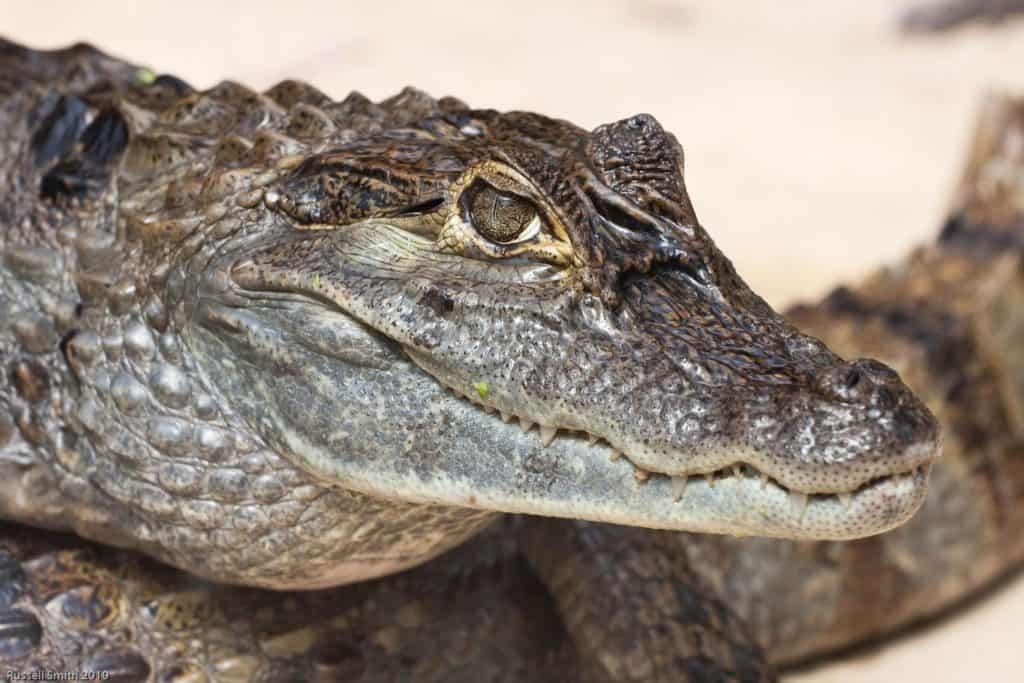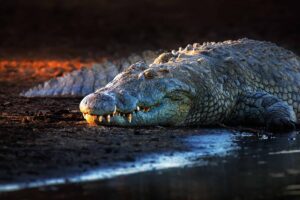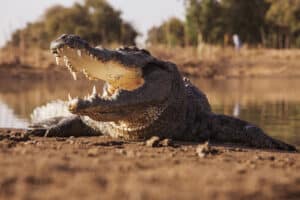The order Crocodilia has been has been around for over 95 million years, and all share similar behaviors and characteristics. Today it includes crocodiles, alligators, caimans, and gharials.
They live in temperate climatic conditions throughout the world, with the crocodile exhibiting the most extensive distribution. These reptiles are all fearsome creatures ranging from aggressive to highly aggressive.
Let’s dive into the main differences between alligators vs corocidles vs. caiman vs. gharials.
Comparing Alligator vs. Crocodile vs. Caiman vs. Gharial
| Alligator | Crocodile | Caiman | Gharial | |
| Scientific Name | Alligatoridae | Crocodylidae | Caimaninae | Gavialis gangeticus |
| Length | Up to 13 feet | Up to 20 feet | 3.9 – 14 feet | 10-20 feet |
| Weight (Maximum) | 1,380 pounds | 2,370 pounds | 1,300 pounds | 1,000 pounds |
| Bite Force | 2,200 pounds/feet | 7,700 pounds/feet | 420 pounds/feet (Smaller species) | 450 pounds/feet |
| Diet | Carnivore | Carnivore | Carnivore | Carnivore |
| Lifespan | 80 years in captivity | 100 years in captivity | 20-40 years | 50 – 60 years |
| Incubation | 110 – 120 days | 65 – 95 days | 90 days | 53 – 94 days |
| Water | Fresh | Fresh and Salt Water | Fresh | Fresh |
| Number of species | 2 | 18 | 6 | 2 |
| Predators | Mainly humans | Mainly humans | Mainly humans | Mainly humans |
The Main Differences Between Crocodilians
The main differences between crocodilians is that crocodiles can grow to larger sizes than alligators, caimans, and gharials. In addition, they have anatomy diffences such as the shape of their snouts.
Crocodilians are carnivores and, depending on their age and size, have a varied diet from insects to large mammals. Still, the Gharial is the exception, with its much longer, narrower snout specifically designed for catching and eating fish. Like the Gharial, the Caiman also has a long pointy snout, but it is nowhere near as thin and long as the Gharial. In contrast, the alligator’s mouth is U-shaped, and the crocodile‘s mouth is V-shaped. So, let’s see how the Alligator vs. Crocodile vs. Caiman vs. Gharial pan out.
Alligators vs. Crocodiles vs. Caiman vs. Gharial: Size
The saltwater crocodiles are the biggest and most powerful of all these in the Crocodylia family and are, on average, three feet longer than alligators. Crocodiles are the largest, growing up to 20 feet long and weighing up to 2,370 pounds. Alligators grow up to 13 feet and typically weigh up to 790 pounds, with the largest recorded specimens weighing up to 1,380 pounds. Certain caiman species can be quite small, reaching only 6.6 feet and weighing 88 pounds. However, the Black Caiman is found in the Amazon and can grow to a length of 14 feet, weighing perhaps 1,300 pounds. Finally the Gharial gets up to 20 feet long and weighs up to 1,000 pounds.
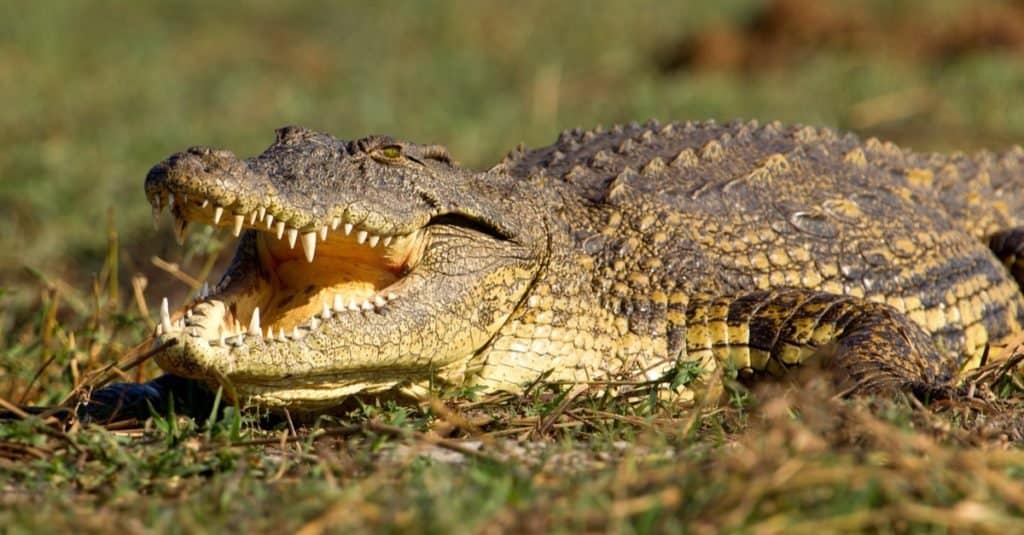
Crocodiles have a length of up to 20 feet, a weight of up to 2,370 pounds, and a bite force of 7,700 pounds/feet.
©Gaston Piccinetti/Shutterstock.com
Alligators vs. Crocodiles vs. Caiman vs. Gharial: Behavior
All four members of this Crocodylia family are apex predators and range from aggressive to highly aggressive. Alligators and caiman prefer to hide among the bushes and hunt at night and try to avoid humans but make no mistake, if you corner or threaten them or their young, your life will be in danger. Crocodiles are far more aggressive, especially saltwater crocodiles. The Nile crocodile is responsible for 300 deaths annually. Crocodiles are so much more aggressive because they are so much more sensitive to noise and disturbances in the water because they have a DPR (domed pressure sensor) on almost every scale of their bodies. In contrast, the alligator only has a DPR in its jaw.
Alligators vs. Crocodiles vs. Caiman vs. Gharial: Where Are They Found?
Alligators are found in the United States and Mexico and are a huge tourist attraction in Florida, where they coexist with crocodiles. This place is the only one in the world where alligators and crocodiles share the same space. There is a second species of alligator – the Chinese alligator – that can be found in China. However, they’re extremely rare.
Crocodiles are found all over the world where temperate climates exist. They do not like cold weather. They live across Africa, Asia, America and Australia, the Caribbean, New Guinea, Columbia, Philippines, India, Borneo, Cuba, and Indonesia.
The Caiman crocodile lives in Central and South America and Mexico. The Black Caiman is found in the Amazon and is the largest of the species. The Gharial is located on the Sub-Indian continent and is reportedly almost extinct. All these Crocodylia species live in swamps and estuaries and spend most of their time sleeping on sandbanks.
Alligators vs. Crocodiles vs. Caiman vs. Gharial: Diet
Alligators are apex predators and feed on turtles, coypu, dogs, panthers, bears, muskrats, birds, deer, and snakes. They may be lazy and spend most of their time lying in wait to ambush their prey, but they can be swift when they lunge to attack. Their target is dependent on their size and age.
Freshwater crocodiles feed mainly on insects and small mammals, whereas the larger cousin, the saltwater crocodile, feeds on larger mammals and even humans if given the opportunity.
The Caiman crocodile’s main diet consists of piranha and catfish, but they also eat birds, turtles, and large mammals.
Adult Gharials’ main diet consists of fish for which their long snout with 110 razor-sharp teeth is ideally suited.
Alligators vs. Crocodiles vs. Cayman vs. Gharial: Reproduction
American alligators breed during the warm months from April through June. The female is pregnant for approximately 63 to 68 days, and her eggs usually hatch within 60 days. The baby alligators hatch from early August to the first week or so in September. About 30% of the eggs are lost to raccoons and flooding, which leaves an average clutch of about 38 baby alligators.
Crocodiles mate from late June to mid-August when confined to pools before the rainy season starts. Then, the females choose high sand banks to lay their eggs, which hatch during December. The females are pregnant for three to six weeks before laying their eggs, and the eggs take from nine to ten weeks to hatch.
Female Caiman lay between ten and 50 eggs during July and August, which take about six weeks to hatch.
The Gharial mating season lasts from November to December and can extend into January. The nesting and laying of eggs occur from March to May when the rivers are low and more sand is exposed on the banks. The female can lay up to 60 eggs at a time.
All the species mate and breed once a year only.
Alligators vs. Crocodiles vs. Caiman vs. Gharial: Bite Force
The bite force of these Crocodylia species varies according to size and species as follows:
- Alligator – 2200 pounds/feet
- Crocodile – 7700 pounds / feet
- Caiman (smaller specis) – 420 pounds/feet
- Gharial – 450 pounds/feet
It’s interesting to know that the bite force of a great white shark is 4.000 pounds/feet, which is less than that of the biggest crocodile. As powerful as the bite is of these creatures, it is possible to hold their jaws closed with your bare hands. Their jaws are routinely taped with duct tape when caught and transported.
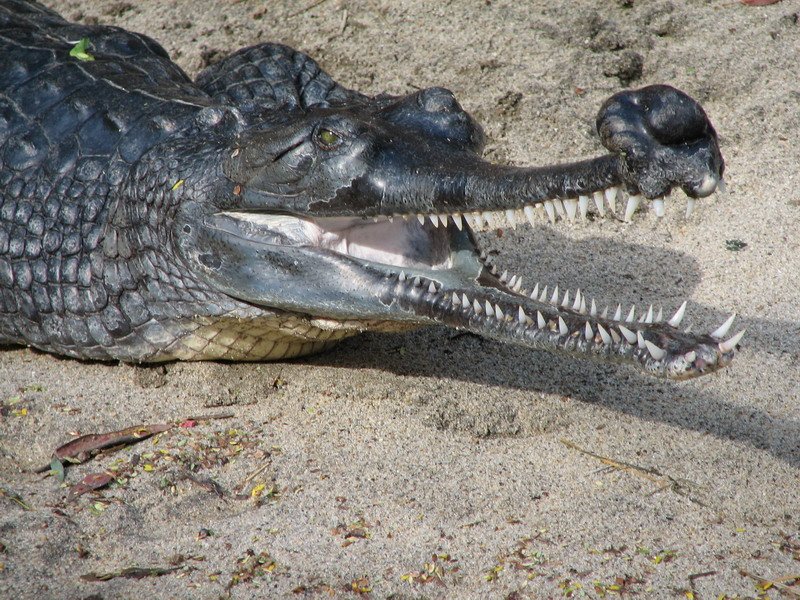
The Gharial grows beyond 10 feet, typically weighs 350 – 400 pounds, and has a bite force of 450 pounds/feet.
©Justin Griffiths / Public Domain, Wikimedia Commons – License
Alligators vs. Crocodiles vs. Caiman vs. Gharial: Predators
All of these are apex predators and are only vulnerable to predators when they are hatchlings and juveniles. When they reach adulthood, their only predators are humans.
Bonus: Where Can You Find Crocodiles and Alligators Together?
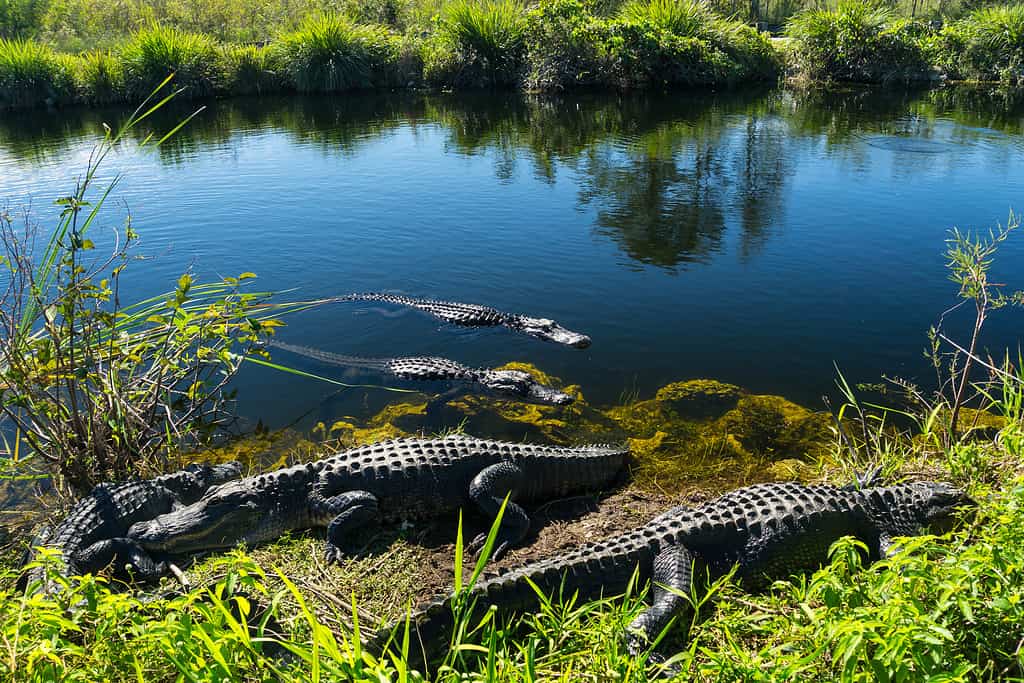
The Florida Everglades is the only place in the world where crocodiles and alligators coexist.
©Simon Dux/iStock via Getty Images
There is only one place on earth where you can find both alligators and crocodiles coexisting in one environment – the Florida Everglades! Alligators can only survive in freshwater – while crocodiles can exist in both fresh and saltwater – often preferring a brackish mixture of both. The hot, humid, swampy atmosphere of the Everglades is the perfect environment for both animals – who actually seem to get along just fine with each other.
Both animals are extremely dangerous and are to be avoided – but the alligators are actually much more docile than their croc cousins. Alligators tend to attack only when provoked or hungry – but crocodiles are known to attack just because someone is near them. Crocodiles are much more active in the water and spend less time sunbathing like alligators. The Everglades is home to more than 1,000 crocodiles and 200,000 alligators.
The photo featured at the top of this post is © Mari Swanepoel/Shutterstock.com
Thank you for reading! Have some feedback for us? Contact the AZ Animals editorial team.




